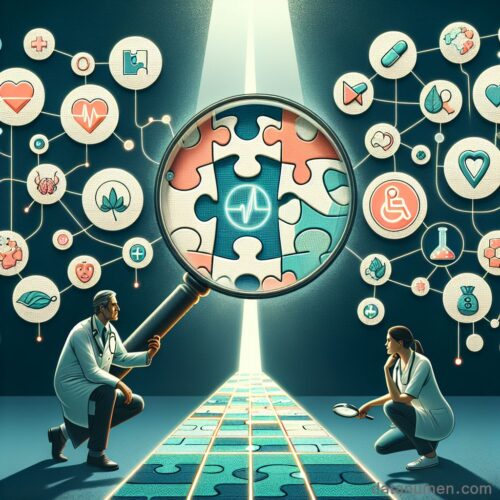1. The Mysterious Symptoms
On a typical day in the clinic, a patient walks in with a mysterious set of symptoms that leave the healthcare professionals scratching their heads. The symptoms presented by the patient seem to be a complex and perplexing combination that does not fit neatly into any known diagnosis or explanation.
As the healthcare team gathers around the patient, they observe with keen interest and concern, trying to decipher the underlying cause of this unusual presentation. The patient’s distress is palpable, adding a sense of urgency to the situation.
Despite their years of experience and extensive medical knowledge, the healthcare professionals find themselves stumped by this puzzling case. They re-examine the patient’s medical history, perform various tests, and consult with other specialists, but the mystery only deepens.
Each symptom presents a new challenge, leading the team down a path of endless possibilities and uncertainties. The medical professionals work tirelessly to unravel the mystery, knowing that the answer could hold the key to providing the patient with much-needed relief and treatment.
As the investigation into the mysterious symptoms intensifies, the healthcare team remains dedicated and determined to uncover the truth behind this baffling case. Their collaborative efforts and unwavering commitment highlight the importance of persistence and teamwork in the face of medical mysteries.

2. The Initial Investigations
The medical team initiates a series of comprehensive tests and analyses aimed at uncovering the underlying cause of the symptoms presented by the patient. These investigations are crucial in providing valuable insights into the individual’s health condition and guiding the subsequent course of treatment.
Through a meticulous examination process, the team delves deep into various aspects of the patient’s medical history, lifestyle, and any notable environmental factors. This holistic approach ensures that no stone is left unturned in identifying potential triggers or contributors to the symptoms.
Furthermore, advanced diagnostic tools and techniques are employed to obtain accurate and detailed information about the patient’s physiological functions. Blood tests, imaging studies, and specialized assessments are among the key components of this investigative phase, allowing for a thorough understanding of the body’s internal workings.
By collecting and analyzing data from these tests, the medical team can pinpoint the specific issues that may be responsible for the symptoms experienced by the patient. This critical information serves as the foundation for developing a personalized and effective treatment plan tailored to address the root cause of the medical concerns.

3. A Familiar Pattern Emerges
Patterns in the patient’s medical history begin to reveal themselves, shedding light on potential causes for their condition. As healthcare professionals delve deeper into the patient’s past, they start to notice recurring themes that point towards specific underlying issues.
Connecting the Dots
By carefully analyzing the patient’s medical records, doctors and specialists can identify patterns that may have gone unnoticed before. These patterns could be related to certain symptoms, test results, or past treatments that all seem to lead back to a common thread.
Exploring New Avenues
As the familiar pattern emerges, it opens up new avenues of exploration for the medical team. They may decide to conduct further tests or consultations in order to confirm their suspicions and develop a targeted treatment plan.
Collaborative Efforts
Collaboration among healthcare professionals becomes crucial at this stage, as different specialists bring their expertise to the table to decipher the patterns in the patient’s medical history. Each member of the team plays a vital role in uncovering the underlying causes and determining the best course of action.

4. The Race Against Time
As the patient’s health deteriorates, the team works tirelessly to piece together the puzzle before it’s too late.
In this crucial stage of the medical emergency, the urgency intensifies as the patient’s condition worsens. With each passing moment, the team is racing against time to make sense of the complex symptoms and find a solution. Every member of the team is fully focused and dedicated, working together seamlessly to unravel the mystery and provide the necessary treatment.
The pressure is palpable as the clock ticks away, driving the team to work even harder. Every detail is scrutinized, every possibility explored, as they strive to identify the root cause of the patient’s deteriorating health. The stakes are high, and the team knows that they must act swiftly and decisively to have any chance of saving the patient’s life.
Despite the challenges and obstacles they face, the team remains undeterred. Their determination and resilience shine through as they continue to work tirelessly, refusing to give up until they have exhausted every avenue and explored every lead. It is a race against time, but the team is determined to emerge victorious, no matter the odds.

5. The Breakthrough Diagnosis
As the investigation unfolded, with each new lead leading to a dead end, hope was starting to dwindle. The medical team had exhausted all conventional diagnostic tests, leaving them at a loss as to what was causing the patient’s symptoms. Just when it seemed like all hope was lost, a breakthrough diagnosis was made.
After countless hours of research, collaboration, and brainstorming sessions, a team of specialists finally connected the dots. They discovered a rare condition that perfectly explained the unusual combination of symptoms the patient was experiencing. It was a moment of clarity, as everything started to make sense.
The breakthrough diagnosis not only solved the medical mystery but also provided a sense of relief for the patient and their loved ones. Finally, there was a light at the end of the tunnel, a path forward for treatment and recovery.
This pivotal moment marked a turning point in the case, as the medical team could now focus on developing a customized treatment plan to address the root cause of the patient’s illness. It was a moment of triumph, a testament to the dedication and perseverance of the team that never gave up on finding the answers.
The breakthrough diagnosis was a reminder of the importance of persistence and collaboration in the field of medicine. It showcased the power of teamwork and the impact it can have on bringing forth solutions to even the most challenging cases.

6. The Treatment Plan
After a thorough diagnosis has been made, the healthcare team collaborates to create a comprehensive treatment plan tailored to meet the specific needs of the patient. This plan is essential in guiding the patient towards recovery and helping them regain their health.
The treatment plan typically includes a combination of medical interventions, therapeutic treatments, lifestyle changes, and follow-up care. Each aspect of the plan is carefully designed to address the underlying causes of the patient’s condition and to promote healing.
Medical interventions may include medication, surgery, or other procedures aimed at treating the illness or injury. Therapeutic treatments such as physical therapy, counseling, or occupational therapy may also be recommended to help the patient regain function and improve their quality of life.
In addition to medical and therapeutic interventions, lifestyle changes such as diet modifications, exercise routines, and stress management techniques are often incorporated into the treatment plan. These changes help address risk factors, improve overall health, and support the patient’s recovery.
Follow-up care is an integral part of the treatment plan, ensuring that the patient’s progress is monitored, and adjustments can be made as needed. Regular appointments and check-ins with the healthcare team help track the patient’s recovery and address any concerns that may arise.
Overall, the treatment plan is a crucial roadmap for the patient’s journey to health and wellness, providing guidance, support, and a clear path towards recovery.

Leave a Reply